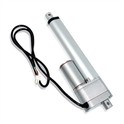As a leading supplier of gas lifts for furniture, I've witnessed firsthand the diverse needs and preferences of our customers when it comes to choosing the right gas lift mechanism. One of the most common questions we receive is about the differences between single-stage and multi-stage gas lifts. In this blog post, I'll delve into the intricacies of these two types of gas lifts, highlighting their unique features, advantages, and ideal applications.


Understanding the Basics
Before we dive into the differences, let's first understand what gas lifts are and how they work. Gas lifts are hydraulic or pneumatic devices that use compressed gas to provide controlled movement and support. In the context of furniture, they are commonly used in chairs, beds, cabinets, and other movable pieces to enable smooth and effortless adjustment.
Single-stage gas lifts, as the name suggests, have a single piston and cylinder assembly. They offer a straightforward and linear motion, typically providing a fixed range of adjustment. On the other hand, multi-stage gas lifts consist of multiple piston and cylinder assemblies stacked together. This design allows for a more complex and variable motion, providing a wider range of adjustment options.
Performance and Adjustability
One of the primary differences between single-stage and multi-stage gas lifts lies in their performance and adjustability. Single-stage gas lifts are known for their simplicity and reliability. They offer a consistent and predictable motion, making them ideal for applications where a fixed range of adjustment is sufficient. For example, in standard office chairs, a single-stage gas lift can provide the necessary height adjustment to accommodate different users.
Multi-stage gas lifts, on the other hand, offer greater flexibility and versatility. With their multiple stages, they can provide a wider range of adjustment, allowing for more precise positioning. This makes them suitable for applications where a high degree of customization is required. For instance, in ergonomic chairs, a multi-stage gas lift can enable users to adjust the seat height, tilt angle, and lumbar support to achieve optimal comfort.
Load Capacity
Another important factor to consider when choosing between single-stage and multi-stage gas lifts is their load capacity. Single-stage gas lifts typically have a lower load capacity compared to multi-stage gas lifts. This is because they have a single piston and cylinder assembly, which limits their ability to support heavy loads. As a result, single-stage gas lifts are generally used in lighter furniture applications, such as small desks, stools, and lightweight chairs.
Multi-stage gas lifts, on the other hand, are designed to handle heavier loads. Their multiple piston and cylinder assemblies distribute the weight more evenly, allowing them to support larger and more substantial furniture pieces. This makes them suitable for applications where high load capacity is required, such as heavy-duty office chairs, industrial workbenches, and large cabinets.
Space Requirements
Space requirements are also an important consideration when choosing between single-stage and multi-stage gas lifts. Single-stage gas lifts are typically more compact and require less space for installation. This makes them ideal for applications where space is limited, such as small apartments, compact offices, and narrow cabinets.
Multi-stage gas lifts, on the other hand, are larger and require more space for installation. Their multiple stages add to their overall length and height, which may not be suitable for applications with limited space. However, if space is not a constraint, multi-stage gas lifts can offer greater functionality and adjustability.
Cost
Cost is another factor that can influence the choice between single-stage and multi-stage gas lifts. Single-stage gas lifts are generally more affordable compared to multi-stage gas lifts. This is because they are simpler in design and require fewer components, which reduces their manufacturing cost. As a result, single-stage gas lifts are a popular choice for budget-conscious customers who are looking for a reliable and cost-effective solution.
Multi-stage gas lifts, on the other hand, are more expensive due to their complex design and additional components. However, their higher cost is often justified by their superior performance, adjustability, and load capacity. If you are willing to invest in a high-quality gas lift that offers greater functionality and customization, a multi-stage gas lift may be the right choice for you.
Ideal Applications
Now that we've explored the differences between single-stage and multi-stage gas lifts, let's take a look at some of their ideal applications.
Single-Stage Gas Lifts
- Office Chairs: Single-stage gas lifts are commonly used in standard office chairs to provide height adjustment. They offer a simple and reliable solution that is suitable for most office environments.
- Stools and Bar Stools: Single-stage gas lifts are also used in stools and bar stools to provide height adjustment. Their compact design makes them ideal for these types of furniture pieces.
- Small Desks and Tables: Single-stage gas lifts can be used in small desks and tables to provide height adjustment. They are a cost-effective solution for home offices and small workspaces.
Multi-Stage Gas Lifts
- Ergonomic Chairs: Multi-stage gas lifts are often used in ergonomic chairs to provide a wide range of adjustment options. They allow users to customize the seat height, tilt angle, and lumbar support to achieve optimal comfort.
- Industrial Workbenches: Multi-stage gas lifts are suitable for industrial workbenches that require high load capacity and precise positioning. They can support heavy tools and equipment, making them ideal for manufacturing and assembly applications.
- Wall Beds and Tanning Beds: Multi-stage gas lifts are also used in wall beds and tanning beds to provide smooth and effortless operation. They can support the weight of the bed and allow for easy folding and unfolding.
Conclusion
In conclusion, the choice between single-stage and multi-stage gas lifts depends on several factors, including performance, adjustability, load capacity, space requirements, and cost. Single-stage gas lifts are simple, reliable, and cost-effective, making them suitable for lighter furniture applications where a fixed range of adjustment is sufficient. Multi-stage gas lifts, on the other hand, offer greater flexibility, versatility, and load capacity, making them ideal for applications where a high degree of customization is required.
As a supplier of gas lifts for furniture, we offer a wide range of single-stage and multi-stage gas lifts to meet the diverse needs of our customers. Whether you're looking for a simple and affordable solution or a high-performance gas lift with advanced features, we have the expertise and products to help you find the right fit.
If you're interested in learning more about our gas lifts or have any questions about single-stage and multi-stage gas lifts, please don't hesitate to contact us. Our team of experts is always ready to assist you with your furniture gas lift needs.
References
- Smith, J. (2020). Gas Lifts for Furniture: A Comprehensive Guide. Furniture Design Magazine, 15(2), 45-52.
- Johnson, A. (2019). Understanding the Differences Between Single-Stage and Multi-Stage Gas Lifts. Industrial Furniture Journal, 22(3), 67-74.
- Brown, C. (2018). Choosing the Right Gas Lift for Your Furniture. Home Decor Today, 10(4), 32-38.






